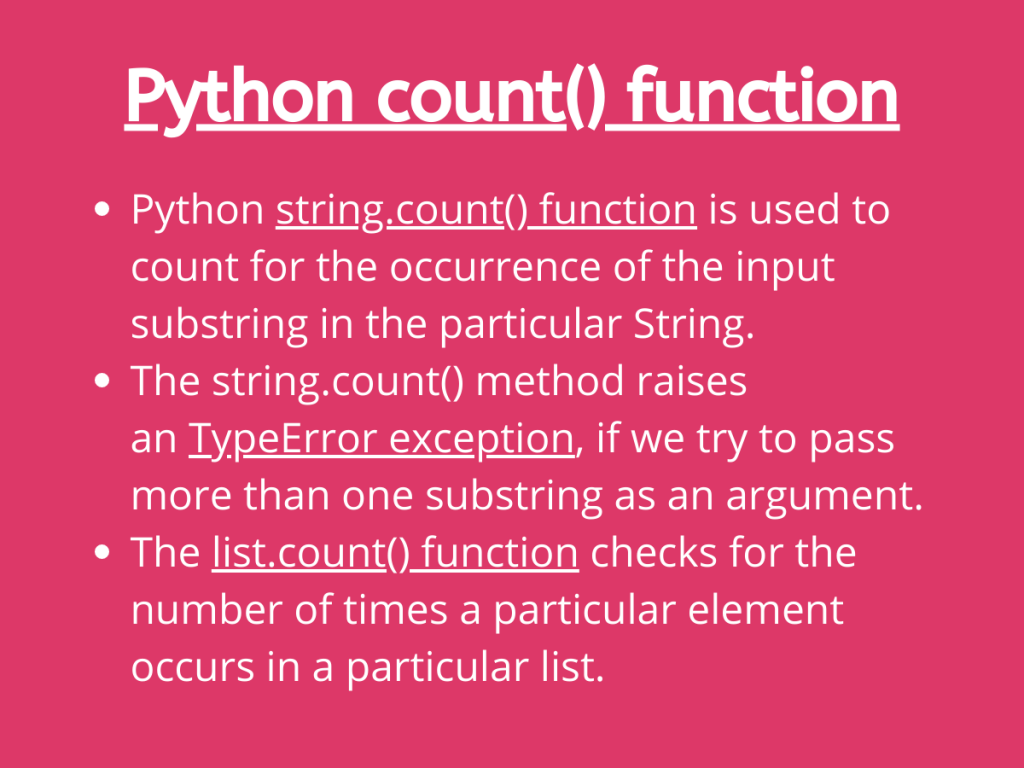Hi, Folks! In this article, we will be focusing on Python count() method with Strings and Lists.
1. Python count() function with Strings
Python String has got an in-built function – string.count() method to count the occurrence of a character or a substring in the particular input string.
The string.count() method accepts a character or a substring as an argument and returns the number of times the input substring happens to appear in the string.
Syntax:
string.count(string, start_index,end_index)
substring(mandatory): The string whose occurrence of presence needs to be counted in the input string.start_index(optional): The index from where the search for the substring starts.end_index(optional): The index where the search for the substring needs to stop.
Example:
inp_str = "JournalDev -- AskPython @ JournalDev"
str_cnt = inp_str.count("JournalDev")
print(str_cnt)
Output:
2
Example 2:
inp_str = "Python Java Python Kotlin"
str_cnt = inp_str.count("Python", 0 , 6)
print(str_cnt)
In the above example, we have passed ‘Python‘ as a substring to be searched and to count for the presence between index 0 – index 6.
Output:
1
Example 3:
inp_str = "Python Java Python Kotlin"
str_len=len(inp_str)
str_cnt = inp_str.count("Python", 5 , str_len )
print(str_cnt)
Here, we search the substring – ‘Python’ and count its occurrence between index 5 to the end of the string that is why we have passed the length of the string as the end_index argument.
Output:
1
Python String count() method: TypeError
Python string.count() accepts only a single substring as an argument. If we try to pass multiple substrings as arguments, it raises the TypeError exception.
Example:
inp_str = "Python Java Python Kotlin"
str_cnt = inp_str.count('Python', 'Java')
print(str_cnt)
Output:
TypeError Traceback (most recent call last)
<ipython-input-40-6084d1350592> in <module>
1 inp_str = "Python Java Python Kotlin"
----> 2 str_cnt = inp_str.count('Python', 'Java')
3 print(str_cnt)
TypeError: slice indices must be integers or None or have an __index__ method
2. Python List count() function
Python list has got a list.count() method to count the occurrence of particular elements in a list.
The list.count() method counts the occurrence of a particular value/ data item present in the input list.
Syntax:
list.count(value)
Example 1:
inp_lst = ['Apple','Banana','Apple','Grapes','Jackfruit','Apple']
lst_cnt = inp_lst.count('Apple')
print(lst_cnt)
Output:
3
Example 2:
inp_lst = [ ['Rat','Cat'], ['Heat','Beat'], ['Rat','Cat'] ]
lst_cnt = inp_lst.count(['Rat','Cat'])
print(lst_cnt)
In the above example, we basically count the occurrence of a nested list [‘Rat’, ‘Cat’] inside the list.
Output:
2
Python count() function at a glance!
- Python
string.count() functionis used to count for the occurrence of the input substring in the particular String. - The string.count() method raises an
TypeError exception, if we try to pass more than one substring as an argument. - The
list.count() functionchecks for the number of times a particular element occurs in a particular list.
Conclusion
Thus, in this article, we have understood the working of in-built Python count function with Strings and Lists.
References
- Python String count() function – JournalDev
